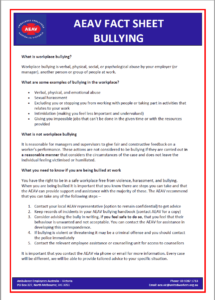What is workplace bullying?
Workplace bullying is verbal, physical, social, or psychological abuse by your employer (or manager), another person or group of people at work.
What are some examples of bullying in the workplace?
- Verbal, physical, and emotional abuse
- Sexual harassment
- Excluding you or stopping you from working with people or taking part in activities that relates to your work
- Intimidation (making you feel less important and undervalued)
- Giving you impossible jobs that can’t be done in the given time or with the resources provided
What is not workplace bullying
It is reasonable for managers and supervisors to give fair and constructive feedback on a worker’s performance. These actions are not considered to be bullying if they are carried out in a reasonable manner that considers the circumstances of the case and does not leave the individual feeling victimised or humiliated.
What you need to know if you are being bullied at work
You have the right to be in a safe workplace free from violence, harassment, and bullying. When you are being bullied it is important that you know there are steps you can take and that the AEAV can provide support and assistance with the majority of these. The AEAV recommend that you can take any of the following steps –
- Contact your local AEAV representative (option to remain confidential) to get advice
- Keep records of incidents in your AEAV bullying handbook (contact AEAV for a copy)
- Consider advising the bully in writing, if you feel safe to do so, that you feel that their behaviour is unwanted and not acceptable. You can contact the AEAV for assistance in developing this
- If bullying is violent or threatening it may be a criminal offense and you should contact the police immediately
- Contact the relevant employee assistance or counselling unit for access to counsellors
It is important that you contact the AEAV via phone or email for more information. Every case will be different, we will be able to provide tailored advice to your specific situation.
Download this factsheet below.

